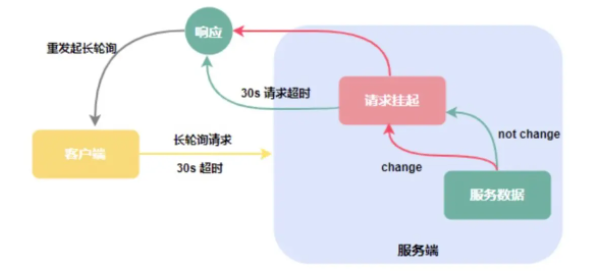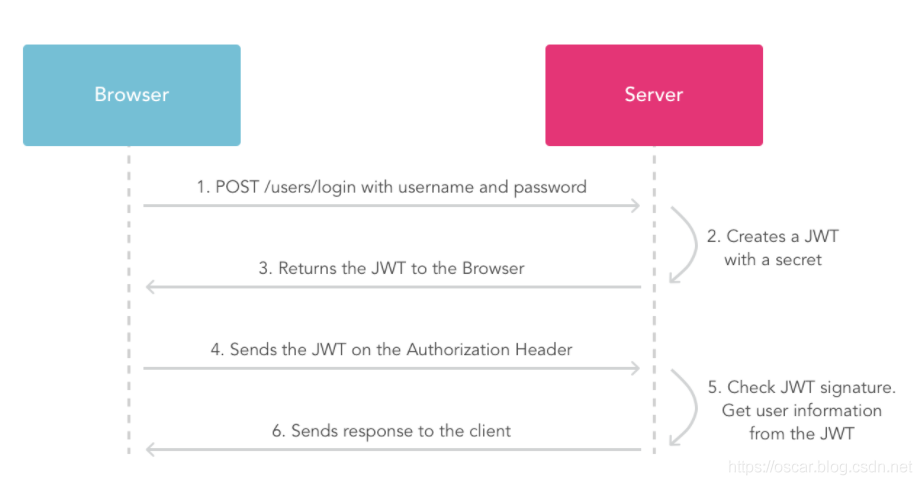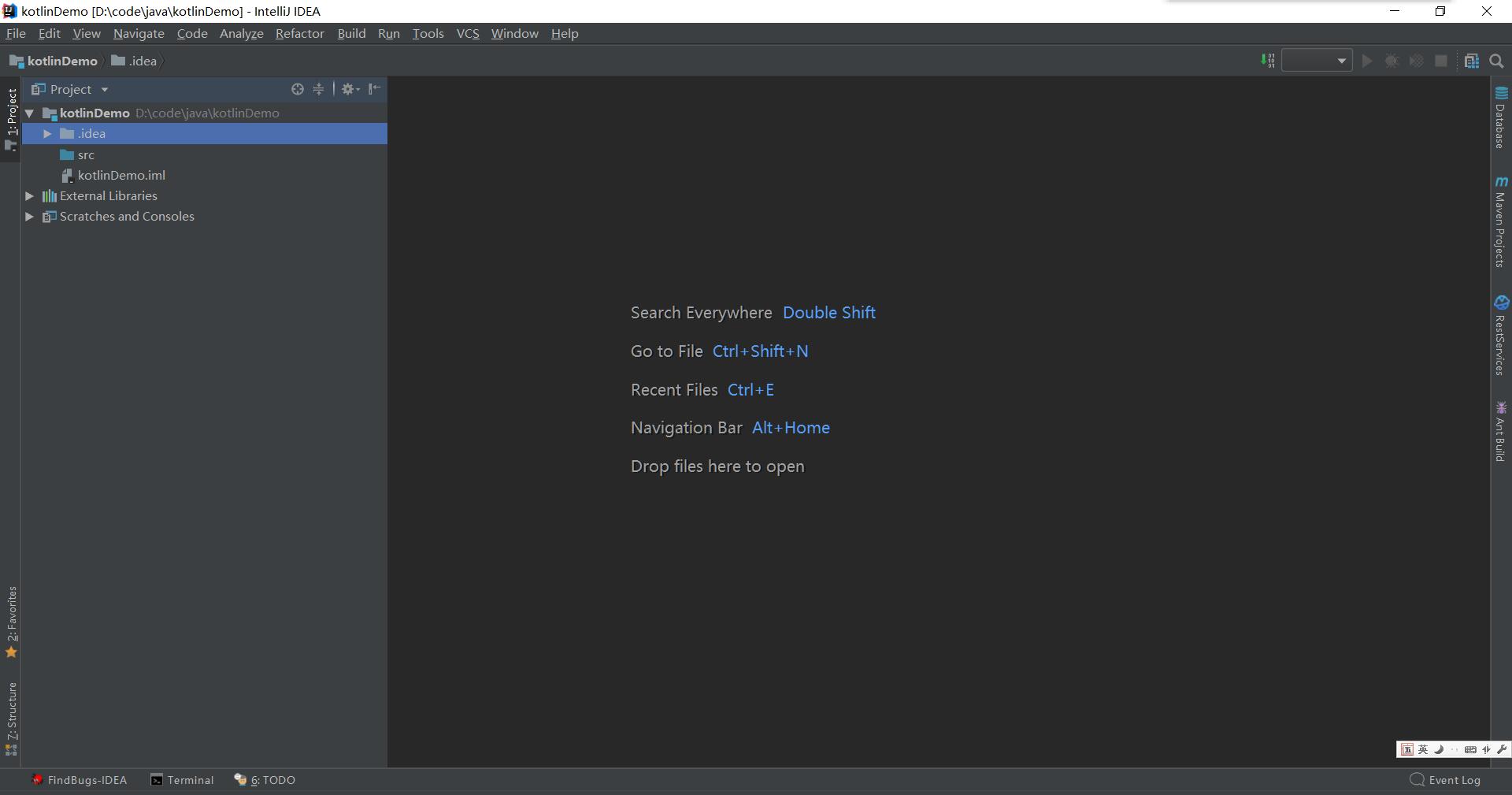分析一下长轮询的实现方式
现在各大中间件都使用了长轮询的数据交互方式,目前比较流行的例如Nacos的配置中心,RocketMQ Pull(拉模式)消息等,它们都是采用了长轮询方的式实现。就例如Nacos的配置中心,如何做到服务端感知配置变化实时推送给客户端的呢?
长轮询与短轮询
说到长轮询,肯定存在和它相对立的,我们暂且叫它短轮询吧,我们简单介绍一下短轮询:
短轮询也是拉模式。是指不管服务端数据有无更新,客户端每隔定长时间请求拉取一次数据,可能有更新数据返回,也可能什么都没有。如果配置中心使用这样的方式,会存在以下问题:
由于配置数据并不会频繁变更,若是一直发请求,势必会对服务端造成很大压力。还会造成推送数据的延迟,比如:每10s请求一次配置,如果在第11s时配置更新了,那么推送将会延迟9s,等待下一次请求;
无法在推送延迟和服务端压力两者之间中和。降低轮询的间隔,延迟降低,压力增加;增加轮询的间隔,压力降低,延迟增高。
长轮询为了解决短轮询存在的问题,客户端发起长轮询,如果服务端的数据没有发生变更,会hold住请求,直到服务端的数据发生变化,或者等待一定时间超时才会返回。返回后,客户端再发起下一次长轮询请求监听。
这样设计的好处:
- 相对于低延时,客户端发起长轮询,服务端感知到数据发生变更后,能立刻返回响应给客户端。
- 服务端的压力减小,客户端发起长轮询,如果数据没有发生变更,服务端会hold住此次客户端的请求,hold住请求的时间一般会设置到30s或者60s,并且服务端hold住请求不会消耗太多服务端的资源。
下面借用图片来说明一下流程:

- 首先客户端发起长轮询请求,服务端收到客户端的请求,这时会挂起客户端的请求,如果在服务端设计的30s之内都没有发生变更,服务端会响应回客户端数据没有变更,客户端会继续发送请求。
- 如果在30s之内服务数据发生了变更,服务端会推送变更的数据到客户端。
配置中心长轮询设计

上面我们已经介绍了整个思路,下面我们用代码实现一下:
- 首先客户端发送一个HTTP请求到服务端;服务端会开启一个异步线程,如果一直没有数据变更会挂起当前请求(一个 Tomcat 也就 200 个线程,长轮询也不应该阻塞 Tomcat 的业务线程,所以需要配置中心在实现长轮询时往往采用异步响应的方式来实现,而比较方便实现异步 HTTP 的常见手段便是 Servlet3.0 提供的 AsyncContext 机制。)
- 在服务端设置的超时时间内仍然没有数据变更,那就返回客户端一个没有变更的标识。例如响应304状态码;
- 在服务端设置的超时时间内有数据变更了,就返回客户端变更的内容;
配置中心长轮询实现
下面用代码实现长轮询:
客户端实现
@Slf4j
public class ConfigClientWorker {
private final CloseableHttpClient httpClient;
private final ScheduledExecutorService executorService;
public ConfigClientWorker(String url, String dataId) {
this.executorService = Executors.newSingleThreadScheduledExecutor(runnable -> {
Thread thread = new Thread(runnable);
thread.setName("client.worker.executor-%d");
thread.setDaemon(true);
return thread;
});
// ① httpClient 客户端超时时间要大于长轮询约定的超时时间
RequestConfig requestConfig = RequestConfig.custom().setSocketTimeout(40000).build();
this.httpClient = HttpClientBuilder.create().setDefaultRequestConfig(requestConfig).build();
executorService.execute(new LongPollingRunnable(url, dataId));
}
class LongPollingRunnable implements Runnable {
private final String url;
private final String dataId;
public LongPollingRunnable(String url, String dataId) {
this.url = url;
this.dataId = dataId;
}
@SneakyThrows
@Override
public void run() {
String endpoint = url + "?dataId=" + dataId;
log.info("endpoint: {}", endpoint);
HttpGet request = new HttpGet(endpoint);
CloseableHttpResponse response = httpClient.execute(request);
switch (response.getStatusLine().getStatusCode()) {
case 200: {
BufferedReader rd = new BufferedReader(new InputStreamReader(response.getEntity()
.getContent()));
StringBuilder result = new StringBuilder();
String line;
while ((line = rd.readLine()) != null) {
result.append(line);
}
response.close();
String configInfo = result.toString();
log.info("dataId: [{}] changed, receive configInfo: {}", dataId, configInfo);
break;
}
// ② 304 响应码标记配置未变更
case 304: {
log.info("longPolling dataId: [{}] once finished, configInfo is unchanged, longPolling again", dataId);
break;
}
default: {
throw new RuntimeException("unExcepted HTTP status code");
}
}
executorService.execute(this);
}
}
public static void main(String[] args) throws IOException {
new ConfigClientWorker("http://127.0.0.1:8080/listener", "user");
System.in.read();
}
}- httpClient 客户端超时时间要大于长轮询约定的超时时间,不然还没等到服务端返回,客户端自己就超时了。
- 304 响应码标记配置未变更;
- http://127.0.0.1:8080/listener 是服务端地址;
服务端实现
@RestController
@Slf4j
@SpringBootApplication
public class ConfigServer {
@Data
private static class AsyncTask {
// 长轮询请求的上下文,包含请求和响应体
private AsyncContext asyncContext;
// 超时标记
private boolean timeout;
public AsyncTask(AsyncContext asyncContext, boolean timeout) {
this.asyncContext = asyncContext;
this.timeout = timeout;
}
}
// guava 提供的多值 Map,一个 key 可以对应多个 value
private Multimap<String, AsyncTask> dataIdContext = Multimaps.synchronizedSetMultimap(HashMultimap.create());
private ThreadFactory threadFactory = new ThreadFactoryBuilder().setNameFormat("longPolling-timeout-checker-%d")
.build();
private ScheduledExecutorService timeoutChecker = new ScheduledThreadPoolExecutor(1, threadFactory);
// 配置监听接入点
@RequestMapping("/listener")
public void addListener(HttpServletRequest request, HttpServletResponse response) {
String dataId = request.getParameter("dataId");
// 开启异步!!!
AsyncContext asyncContext = request.startAsync(request, response);
AsyncTask asyncTask = new AsyncTask(asyncContext, true);
// 维护 dataId 和异步请求上下文的关联
dataIdContext.put(dataId, asyncTask);
// 启动定时器,30s 后写入 304 响应
timeoutChecker.schedule(() -> {
if (asyncTask.isTimeout()) {
dataIdContext.remove(dataId, asyncTask);
response.setStatus(HttpServletResponse.SC_NOT_MODIFIED);
// 标志此次异步线程完成结束!!!
asyncContext.complete();
}
}, 30000, TimeUnit.MILLISECONDS);
}
// 配置发布接入点
@RequestMapping("/publishConfig")
@SneakyThrows
public String publishConfig(String dataId, String configInfo) {
log.info("publish configInfo dataId: [{}], configInfo: {}", dataId, configInfo);
Collection<AsyncTask> asyncTasks = dataIdContext.removeAll(dataId);
for (AsyncTask asyncTask : asyncTasks) {
asyncTask.setTimeout(false);
HttpServletResponse response = (HttpServletResponse)asyncTask.getAsyncContext().getResponse();
response.setStatus(HttpServletResponse.SC_OK);
response.getWriter().println(configInfo);
asyncTask.getAsyncContext().complete();
}
return "success";
}
public static void main(String[] args) {
SpringApplication.run(ConfigServer.class, args);
}
}- 客户端请求过来,首先开启一个异步线程
request.startAsync(request, response);保证不占用Tomcat线程。此时Tomcat线程以及释放。配合asyncContext.complete()使用。 dataIdContext.put(dataId, asyncTask);会将 dataId 和异步请求上下文给关联起来,方便配置发布时,拿到对应的上下文Multimap<String, AsyncTask> dataIdContext它是一个多值 Map,一个 key 可以对应多个 value,你也可以理解为Map<String,List<AsyncTask>>timeoutChecker.schedule()启动定时器,30s 后写入 304 响应@RequestMapping("/publishConfig"),配置发布的入口。配置变更后,根据 dataId 一次拿出所有的长轮询,为之写入变更的响应。asyncTask.getAsyncContext().complete();表示这次异步请求结束了。
启动配置监听
先启动 ConfigServer,再启动 ConfigClient。30s之后控制台打印第一次超时之后收到服务端304的状态码
16:41:14.824 [client.worker.executor-%d] INFO cn.haoxiaoyong.poll.ConfigClientWorker - longPolling dataId: [user] once finished, configInfo is unchanged, longPolling again
请求一下配置发布,请求localhost:8080/publishConfig?dataId=user&configInfo=helloworld
服务端打印日志:
2022-08-25 16:45:56.663 INFO 90650 --- [nio-8080-exec-2] cn.haoxiaoyong.poll.ConfigServer : publish configInfo dataId: [user], configInfo: helloworld
到此这篇关于Java实现一个简单的长轮询的示例代码的文章就介绍到这了,更多相关Java长轮询内容请搜索好代码网以前的文章或继续浏览下面的相关文章希望大家以后多多支持好代码网!





